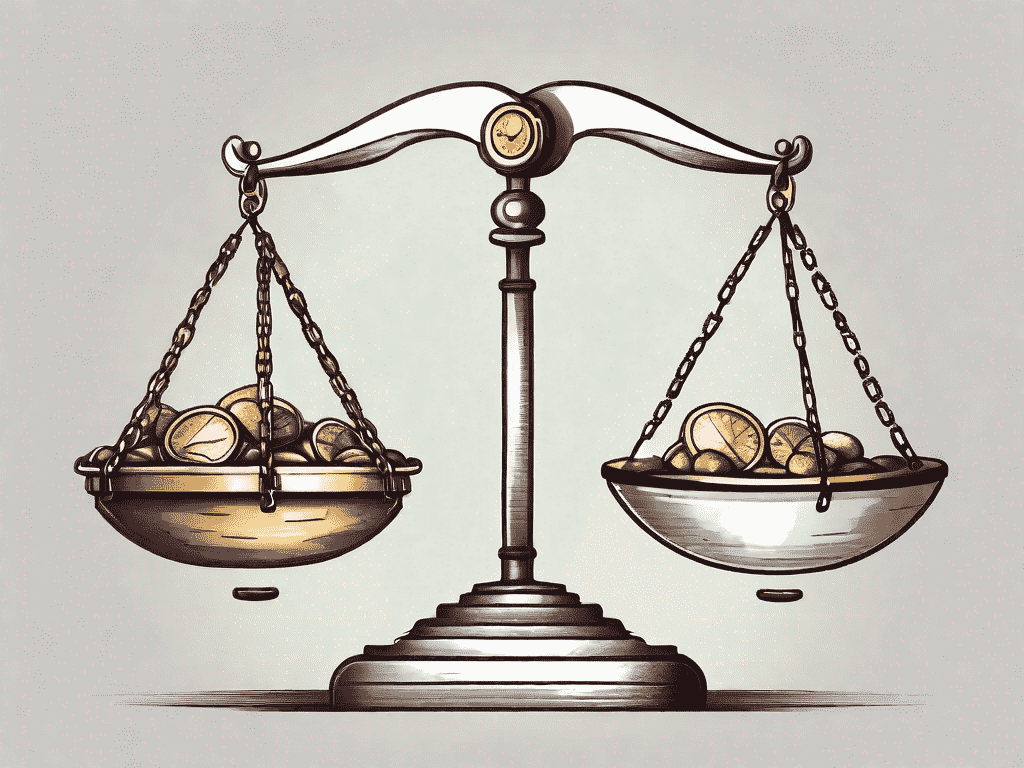
Understanding Customer Lifetime Value: How Does It Work?
Customer Lifetime Value (CLV) is a crucial metric that helps businesses understand the long-term value of their customers. By calculating and analyzing CLV, companies can make informed decisions regarding marketing, customer retention, and budget allocation. In this article, we will explore what CLV is, how to calculate it, the factors influencing it, and how businesses can utilize it effectively. We will also discuss the challenges associated with measuring and applying CLV.
Defining Customer Lifetime Value (CLV)
Customer Lifetime Value, commonly referred to as CLV, is a metric that estimates the total worth of a customer throughout their relationship with a business. It takes into account the revenue generated by the customer and factors in their purchasing behavior, retention rate, and profit margin. CLV provides insights into how much a customer is likely to spend over their entire relationship with a company.
When calculating CLV, businesses consider a variety of factors to gain a comprehensive understanding of a customer’s value. These factors include not only the revenue generated by the customer but also their purchasing behavior and patterns. By analyzing these components, businesses can better understand the long-term potential of each customer and make informed decisions to maximize their value.
The Importance of CLV in Business Strategy
Understanding CLV is vital for businesses as it helps them prioritize their resources and focus on high-value customers. By identifying customers with high CLV, companies can tailor their marketing efforts, provide personalized experiences, and ensure customer retention. This strategic approach allows businesses to allocate their resources efficiently, focusing on customers who are more likely to generate significant long-term value.
Moreover, CLV plays a crucial role in setting realistic revenue targets and evaluating the effectiveness of marketing campaigns. By considering the potential value of each customer, businesses can establish achievable goals and measure the success of their marketing initiatives. This data-driven approach enables companies to make data-backed decisions, leading to improved customer acquisition and retention strategies.
Key Components of CLV
Calculating CLV involves considering several key components. The first is the Average Purchase Value, which is the average amount spent by a customer during each transaction. This metric provides insights into the spending habits of customers and helps businesses identify opportunities to increase the average transaction value.
Another crucial component is the Purchase Frequency, which measures how often a customer makes a purchase. By understanding the frequency of customer transactions, businesses can develop strategies to encourage repeat purchases and increase customer loyalty. This can include implementing loyalty programs, offering personalized recommendations, or providing consumer incentives for frequent purchases.
Lastly, the Customer Lifespan refers to the duration of the customer’s relationship with the business. By analyzing the length of the customer’s engagement, businesses can assess their ability to retain customers over time. This information is valuable for developing customer retention strategies and improving overall customer satisfaction.
In conclusion, CLV is a powerful metric that provides businesses with valuable insights into the long-term value of their customers. By understanding CLV and its key components, businesses can make informed decisions, allocate resources effectively, and develop strategies to maximize customer value and satisfaction.
Calculating Customer Lifetime Value
Customer Lifetime Value (CLV) is a crucial metric for businesses to understand the long-term value of their customers. It helps companies make informed decisions about marketing strategies, customer retention efforts, and overall business growth. There are different methods to calculate CLV, depending on the level of complexity and available data. Let’s explore the basic formula and advanced methods for calculating CLV.
Basic Formula for CLV Calculation
The simplest way to calculate CLV is by multiplying the Average Purchase Value by the Purchase Frequency and then multiplying the result by the Customer Lifespan. This formula provides a basic estimate of the customer’s lifetime value. However, it does not take into account factors such as customer churn and the time value of money.
Customer churn refers to the rate at which customers stop doing business with a company over a given period. It is an important factor to consider when calculating CLV because it affects the overall revenue generated by each customer. By factoring in customer churn, businesses can have a more accurate understanding of the value each customer brings over their lifetime.
The time value of money is another crucial aspect to consider when calculating CLV. It recognizes that money received in the future is worth less than money received today due to inflation and the opportunity cost of not having that money available for investment. By incorporating the time value of money into CLV calculations, businesses can better assess the true worth of their customers over time.
Advanced Methods for CLV Calculation
Advanced methods for CLV calculation incorporate more complex models that consider customer churn rates and the time value of money. These methods utilize statistical techniques such as predictive modeling and cohort analysis to provide more accurate estimates of CLV.
Predictive modeling involves using historical customer data to create mathematical models that predict future customer behavior. By analyzing past purchase patterns, customer demographics, and other relevant factors, businesses can forecast future customer value and tailor their marketing strategies accordingly. This approach allows companies to allocate resources more effectively and focus on high-value customers.
Cohort analysis is another powerful technique used in CLV calculation. It involves grouping customers based on shared characteristics or behaviors and analyzing their purchasing patterns over time. By studying cohorts, businesses can identify trends and patterns that can help them understand which customer segments are most valuable and how to optimize their marketing efforts to maximize CLV.
By analyzing customer behavior and segmenting customers into different groups, businesses can gain deeper insights into their CLV and make more informed decisions. Understanding CLV is not only crucial for determining the profitability of individual customers but also for evaluating the overall health and growth potential of a business.
In conclusion, calculating CLV is a multifaceted process that goes beyond a simple formula. It requires considering factors such as customer churn and the time value of money. Advanced methods, such as predictive modeling and cohort analysis, provide businesses with more accurate estimates of CLV and valuable insights into customer behavior. By leveraging these techniques, companies can optimize their marketing strategies, enhance customer retention efforts, and ultimately drive long-term business success.
Factors Influencing Customer Lifetime Value
Several factors can influence CLV, including customer retention rate, rate of discount, and profit margin per customer.
Customer Retention Rate
The customer retention rate measures the percentage of customers who continue to make purchases from a business over a specific period. A high customer retention rate indicates that customers have a strong connection with the brand and are more likely to generate higher CLV.
Customer retention is crucial for businesses as it not only ensures a steady stream of revenue but also reduces the cost of acquiring new customers. When customers remain loyal to a brand, they are more likely to make repeat purchases, refer the brand to others, and become brand advocates. This loyalty leads to increased CLV as the customer continues to contribute to the company’s revenue over an extended period.
Businesses can improve customer retention by providing exceptional customer service, personalized experiences, and loyalty programs. By building strong relationships with customers, businesses can increase their chances of retaining them and maximizing their CLV.
Rate of Discount
The rate of discount is the interest rate used to calculate the present value of future cash flows. By discounting future cash flows, businesses can assess the value of customers’ future purchases in today’s terms. A higher rate of discount reduces the estimated CLV.
The rate of discount plays a significant role in determining the present value of future cash flows. A higher discount rate indicates that the business places more importance on immediate cash flow rather than future revenue. This can result in a lower estimated CLV as the future value of a customer’s purchases is diminished.
However, it is important for businesses to carefully determine the rate of discount. While a higher discount rate may provide short-term gains, it can also lead to a loss of potential long-term revenue. By finding the right balance, businesses can accurately assess the CLV and make informed decisions regarding customer acquisition and retention strategies.
Profit Margin per Customer
The profit margin per customer represents the revenue generated from each customer after subtracting the costs associated with serving them. A higher profit margin per customer increases their CLV, as more revenue is generated from each purchase.
Profit margin per customer is a key metric for businesses as it directly impacts their CLV. By maximizing the profit margin per customer, businesses can increase the overall value of each customer and, subsequently, their CLV. This can be achieved through various strategies such as cost optimization, upselling and cross-selling, and improving operational efficiency.
Furthermore, businesses can also focus on increasing customer lifetime value by providing additional value-added services or products that customers are willing to pay a premium for. By offering unique and differentiated offerings, businesses can not only increase their profit margin per customer but also enhance customer satisfaction and loyalty.
It is important for businesses to regularly analyze and monitor their profit margin per customer to identify areas for improvement and implement effective strategies to increase CLV. By continuously optimizing the profit margin per customer, businesses can maximize the value of each customer and drive long-term profitability.
Utilizing CLV in Business Decisions
CLV is a powerful tool that can guide businesses in making informed decisions. Here are two key areas where CLV can be effectively utilized.
Marketing Budget Allocation Based on CLV
By understanding the CLV of different customer segments, businesses can allocate their marketing budgets more effectively. They can focus resources on acquiring and retaining high-value customers, as they have the potential to generate more revenue over the long term. This approach improves the return on investment for marketing campaigns and maximizes overall profitability.
Customer Segmentation and Personalization Using CLV
CLV can help businesses segment their customers based on their value and preferences. By identifying high-value customers, businesses can tailor their offerings and marketing messages to meet their specific needs and preferences. This personalized approach enhances the customer experience and increases the likelihood of customer loyalty and retention.
Challenges in Measuring and Applying CLV
While CLV provides valuable insights, there are challenges associated with its measurement and application.
Data Collection and Analysis Issues
Accurate CLV calculation requires access to comprehensive and quality data. Gathering customer transaction data, integrating it with other relevant data sources, and performing complex analysis can be time-consuming and challenging. Additionally, data accuracy and privacy concerns may pose further obstacles.
Changing Customer Behavior and Preferences
Customers’ behavior and preferences are constantly evolving, making it challenging to predict their future purchasing patterns accurately. Changes in market trends, competition, and external factors can also impact customer behavior, making CLV calculations less reliable over time.In conclusion, Customer Lifetime Value is a critical metric that provides businesses with insights into the long-term value of their customers. By understanding CLV and utilizing it in decision-making processes, businesses can allocate resources more effectively, personalize the customer experience, and improve overall profitability. However, measuring and applying CLV comes with its own challenges, including data collection and analysis issues and the ever-changing nature of customer behavior. Nonetheless, businesses that can overcome these challenges and leverage CLV effectively will be better positioned to build and maintain successful customer relationships.


